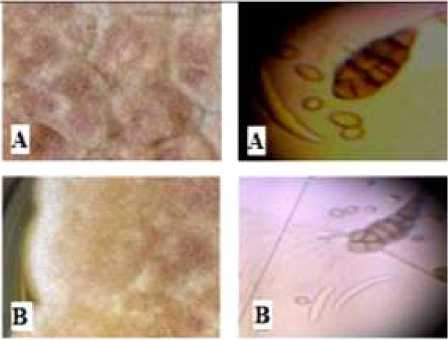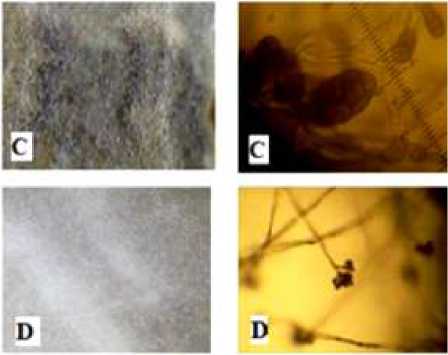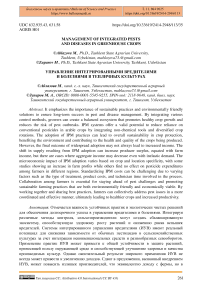Management of integrated pests and diseases in greenhouse crops
Автор: Ablazova M., Zuparov M.
Журнал: Бюллетень науки и практики @bulletennauki
Рубрика: Сельскохозяйственные науки
Статья в выпуске: 4 т.11, 2025 года.
Бесплатный доступ
It emphasizes the importance of sustainable practices and environmentally friendly solutions to ensure long-term success in pest and disease management. By integrating various control methods, growers can create a balanced ecosystem that promotes healthy crop growth and reduces the risk of pest outbreaks. IPM systems offer a valid potential to reduce reliance on conventional pesticides in arable crops by integrating non-chemical tools and diversified crop rotations. The adoption of IPM practices can lead to overall sustainability in crop protection, benefiting the environment and contributing to the health and quality of the crops being produced. However, the final outcome of widespread adoption may not always lead to increased income. The shift in supply resulting from IPM adoption can increase producer surplus, equated with farm income, but there are cases where aggregate income may decrease even with inelastic demand. The microeconomic impact of IPM adoption varies based on crop and location specificity, with some studies showing an increase in farm profits while others find no effect on pesticide expenditures among farmers in different regions. Standardizing IPM costs can be challenging due to varying factors such as the type of treatment, product costs, and technician time involved in the process. Collaboration among farmers is essential for staying ahead of pest challenges and promoting sustainable farming practices that are both environmentally friendly and economically viable. By working together and sharing best practices, farmers can collectively address pest issues in a more coordinated and effective manner, ultimately leading to healthier crops and increased productivity.
Pest, disease, management, greenhouse, crops, comprehensive, product
Короткий адрес: https://sciup.org/14132592
IDR: 14132592 | УДК: 632.935.43, | DOI: 10.33619/2414-2948/113/35
Текст научной статьи Management of integrated pests and diseases in greenhouse crops
Бюллетень науки и практики / Bulletin of Science and Practice
Involves a combination of cultural, biological, and chemical control methods to minimize damage and maximize crop yield. By regularly monitoring pest populations and implementing appropriate control measures, growers can effectively manage pests and diseases while reducing reliance on synthetic pesticides."Integrated Pest and Disease Management in Greenhouse Crops covers pest and disease management strategies and tactics for greenhouse crops, providing case studies with selected crops. The book offers a comprehensive view of the world situation of IPM in greenhouse crops [1].
It also emphasizes the importance of sustainable practices and the use of environmentally friendly solutions to ensure long-term success in pest and disease management. By integrating various control methods, growers can create a balanced ecosystem that promotes healthy crop growth and reduces the risk of pest outbreaks. "IPM systems offer a valid potential to reduce reliance on conventional pesticides in arable crops by integrating non-chemical tools and diversified crop rotations [1].
The adoption of IPM practices can lead to overall sustainability in crop protection [3].
This approach not only benefits the environment but also contributes to the overall health and quality of the crops being produced. By implementing IPM practices, growers can effectively manage pests and diseases while minimizing negative impacts on the ecosystem. Additionally, IPM can help reduce the development of pesticide resistance in pests, making it a more sustainable longterm solution for crop protection. Overall, integrating IPM practices into agriculture can lead to more resilient and productive farming systems. "Integrated pest management (IPM) strategies can increase farm income while reducing pesticide use and external costs associated with pesticides, but the final outcome of widespread adoption of IPM may not always lead to increased income.
The shift in supply resulting from IPM adoption can increase producer surplus, equated with farm income, but there are cases where aggregate income may decrease, even with inelastic demand [2].
Social welfare impacts of IPM can be measured by net social benefits, profit or rent to producers, consumer surplus, producer surplus, external benefits (costs), and social overhead cost for IPM programs [5].
Changes in IPM strategies represent a distinct shift from conventional pest control methods, with potential benefits accruing to producers, consumers, or both depending on the specific case considered [4].
The implementation of IPM on small-scale farms in developed economies faces challenges and opportunities. While some IPM tactics may be easier or more cost-effective to implement on a smaller scale, there are approaches that have not been widely applied in small-scale production but have potential for use. Knowledge gaps and opportunities for increasing IPM outreach to smallscale producers are also identified [6]. Integrated Pest Management (IPM) is considered to be more cost-effective over the long term compared to traditional monthly spray insecticide applications for pest control. While IPM may be more expensive upfront, it requires significantly less pesticide use and can provide superior control even in conditions of poor sanitation. A study comparing IPM and traditional methods for German cockroach control found that IPM controlled infestations effectively and reduced the need for additional pesticide applications, making it a more cost-effective option in the long run [7].
The microeconomic impact of IPM adoption varies based on crop and location specificity, with IPM programs designed for specific crops and regions. Some studies show that IPM adoption may lead to an increase in farm profits, while others find no effect on pesticide expenditures among farmers in different regions. Farmers make adoption choices themselves, leading to differences in farm performance and self-selectivity issues [9].
IPM adoption can result in reduced insecticide applications and compete for managerial time, affecting yields and profits differently across regions [2].
Standardizing IPM costs can be challenging due to varying factors such as the type of treatment, product costs, and technician time involved in the process. The cost of IPM treatments can fluctuate based on the methods used and the products applied, making it difficult to establish a standardized cost across different scenarios. Additionally, the time required for technicians to implement IPM strategies can impact the overall cost, as precision targeting and varied application methods may increase labor expenses [8].
It is important for agricultural businesses to carefully consider these factors when implementing IPM strategies in order to maximize efficiency and minimize costs. By analyzing the specific needs of each region and crop, farmers can tailor their IPM approach to optimize yields and profits. Furthermore, investing in training for technicians can help improve efficiency and reduce labor costs in the long run. Properly implementing IPM strategies can lead to sustainable pest management practices that benefit both the environment and the bottom line of agricultural businesses. Additionally, staying informed about new technologies and research in IPM can help farmers stay ahead of pest challenges and adapt their strategies accordingly.
Collaborating with other farmers or agricultural experts can also provide valuable insights and support in implementing effective IPM practices. By sharing knowledge and experiences, farmers can learn from each other and enhance their pest management techniques. This collaborative approach can lead to a more comprehensive and successful implementation of IPM strategies across the agricultural industry. Ultimately, the goal is to reduce reliance on chemical pesticides and promote sustainable farming practices that are both environmentally friendly and economically viable.
By working together and sharing best practices, farmers can collectively improve pest management outcomes and ensure the long-term health of their crops and ecosystems. Additionally, collaboration among farmers can also help in identifying emerging pest threats and developing innovative solutions to combat them effectively. This proactive approach can contribute to the overall resilience of agricultural systems and mitigate potential risks in the future. Furthermore, collaboration can lead to the sharing of resources and knowledge, reducing individual costs and increasing overall efficiency in pest management.




Figure. A - Fusarium wilt damage on tomatoes, caused by Fusarium oxysporum f. sp. neolycopersici , B - Fusarium wilt damage on green pepper plant, caused by Fusarium oxysporum f. sp. Neolycopersici , C -Late blight damage on tomato leaves, caused by Phytophthora infestans , D - Grey mold damage on green pepper, caused by Botrytis cinerea ; E - Downy mildew damage on cucumber leaves, caused by Pseudoperonospora infestans (Zephaniah Dhlamini)
By fostering a sense of community and cooperation among farmers, sustainable farming practices can be more widely adopted and implemented for the benefit of all involved. Overall, collaboration among farmers is essential for staying ahead of pest challenges and ensuring the longterm sustainability of agriculture. By working together, farmers can collectively address pest issues in a more coordinated and effective manner, ultimately leading to healthier crops and increased productivity. Additionally, collaboration allows for the sharing of best practices and innovative solutions that may not have been previously considered by individual farmers.
This exchange of ideas can lead to more resilient pest management strategies that are adaptable to changing conditions in agriculture. Furthermore, collaboration among farmers can also lead to cost savings by pooling resources and collectively investing in new technologies or research.
This can help farmers remain competitive in the market and improve overall profitability in the long run.
Список литературы Management of integrated pests and diseases in greenhouse crops
- Miller D. M., Meek F. Cost and efficacy comparison of integrated pest management strategies with monthly spray insecticide applications for German cockroach (Dictyoptera: Blattellidae) control in public housing // Journal of Economic Entomology. 2004. V. 97. №2. P. 559-569. DOI: 10.1093/jee/97.2.559
- Bueno A. F., Panizzi A. R., Hunt T. E., Dourado P. M., Pitta R. M., Gonçalves J. Challenges for adoption of integrated pest management (IPM): the soybean example // Neotropical Entomology. 2021. V. 50. P. 5-20. DOI: 10.1007/s13744-020-00792-9 EDN: SICFYB
- Bueno A. D. F., Sutil W. P., Jahnke S. M., Carvalho G. A., Cingolani M. F., Colmenarez Y. C., Corniani N. Biological control as part of the soybean integrated pest management (IPM): Potential and challenges // Agronomy. 2023. V. 13. №10. P. 2532. DOI: 10.3390/agronomy13102532 EDN: QHMZBA
- Fernandez-Cornejo J. The microeconomic impact of IPM adoption: theory and application // Agricultural and resource economics review. 1996. V. 25. №2. P. 149-160. DOI: 10.1017/S1068280500007814
- Atta-Krah K., Chotte J. L., Gascuel C., Gitz V., Hainzelin E., Hubert B., Sinclair F. L. Agroecological transformation for sustainable food systems: insight on France-CGIAR research. 2021.
- Lamichhane J. R. Pesticide use and risk reduction in European farming systems with IPM: An introduction to the special issue // Crop Prot. 2017. V. 97. P. 1-6. DOI: 10.1016/j.cropro.2017.01.017
- Zappella C. Monochrome Painting and the Period Body in Andrea Del Sarto's Cloister of the Scalzo: The University of Chicago, 2022.
- Taylor C. R. The nature of benefits and costs of use of pest control methods // American Journal of Agricultural Economics. V. 62. №5. P. 1007-1011. DOI: 10.2307/1240302
- Grasswitz T. R.Integrated pest management (IPM) for small-scale farms in developed economies: Challenges and opportunities // Insects. 2019. V. 10. №6. P. 179. DOI: 10.3390/insects10060179


